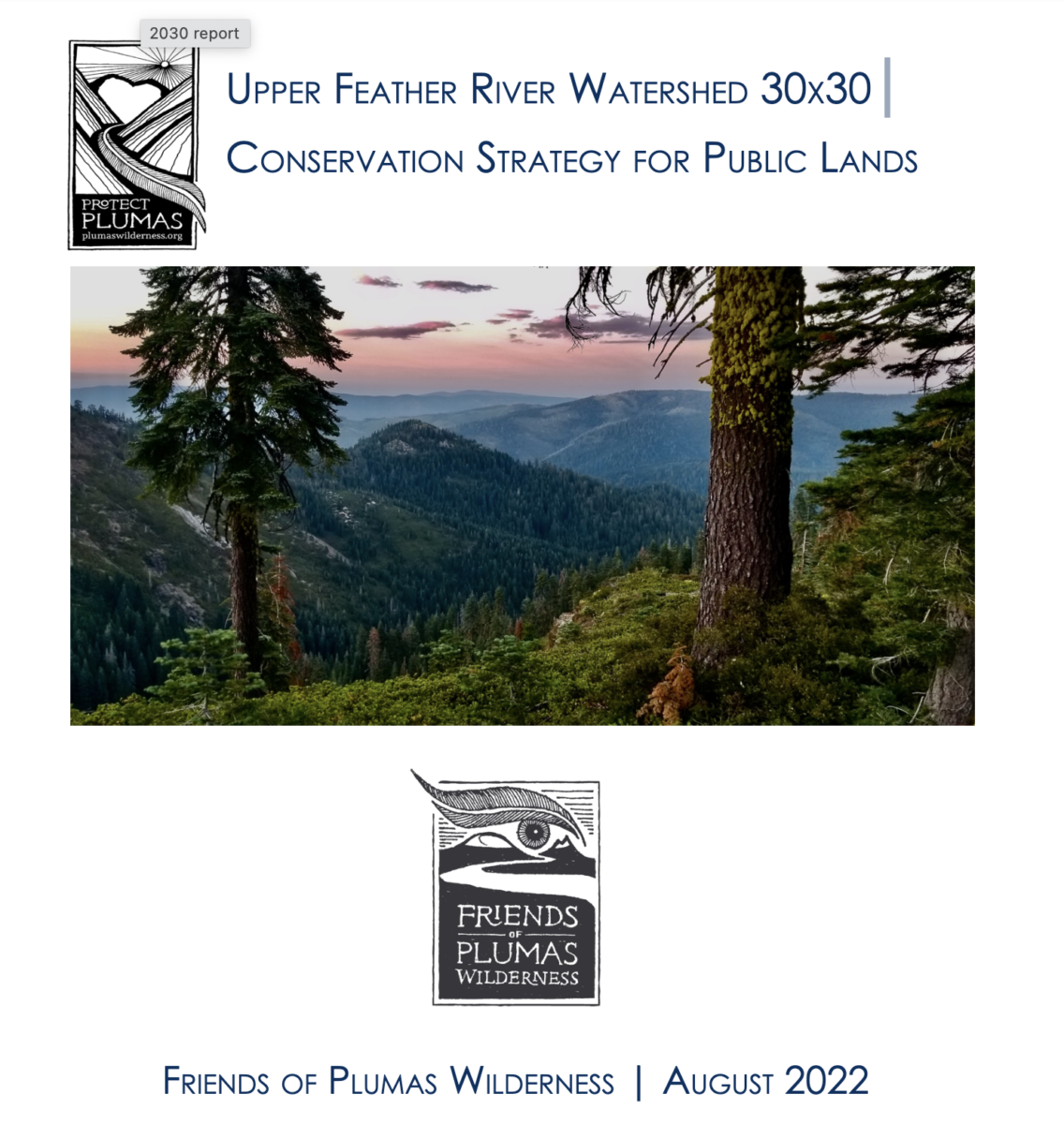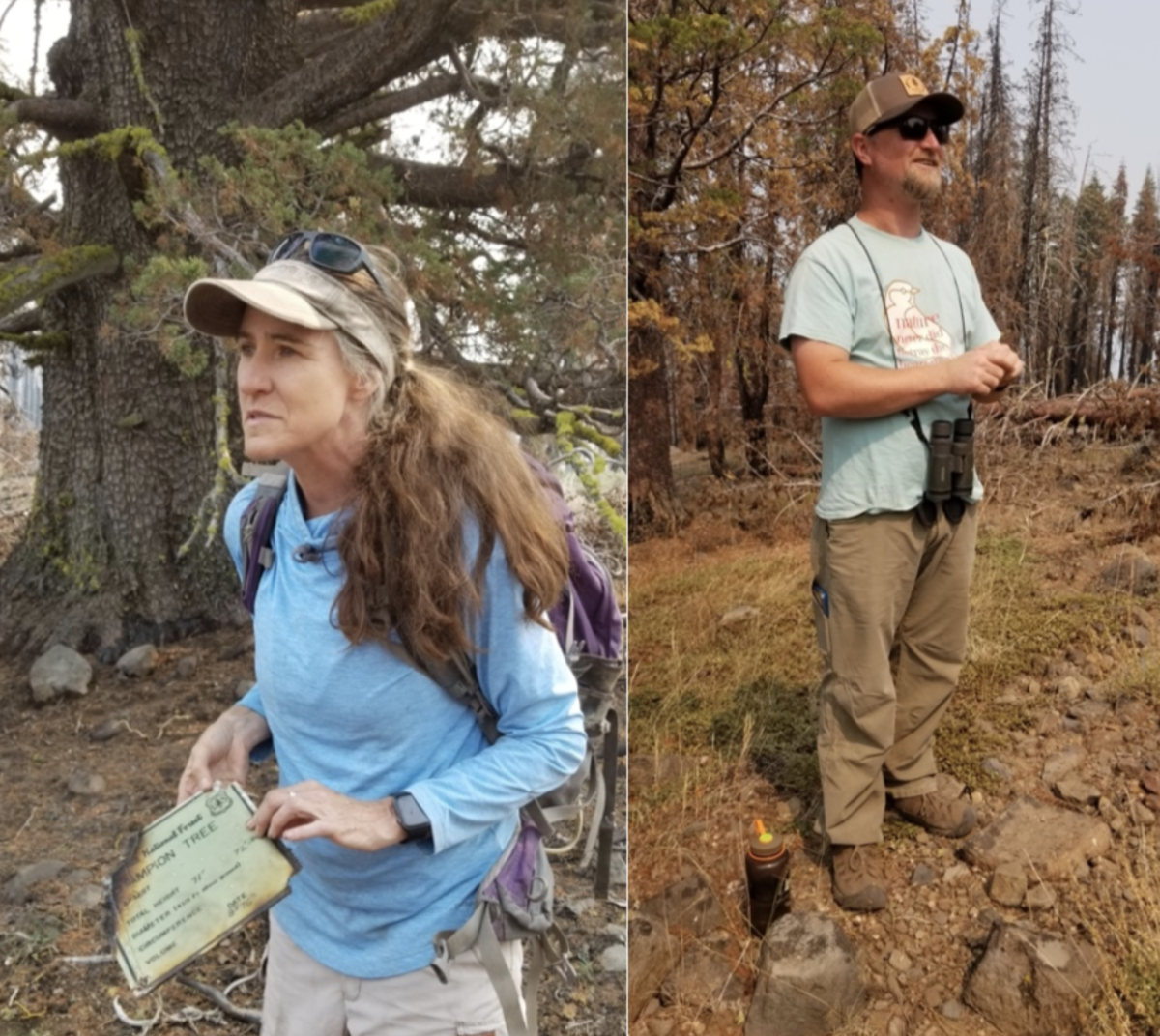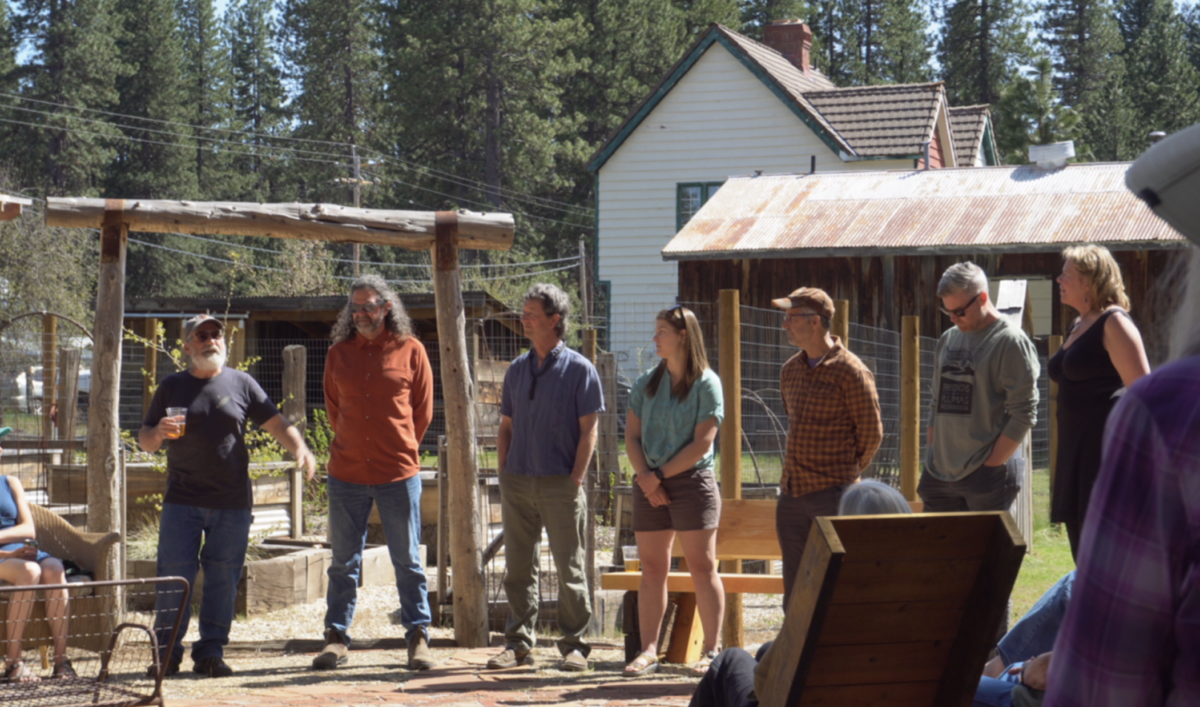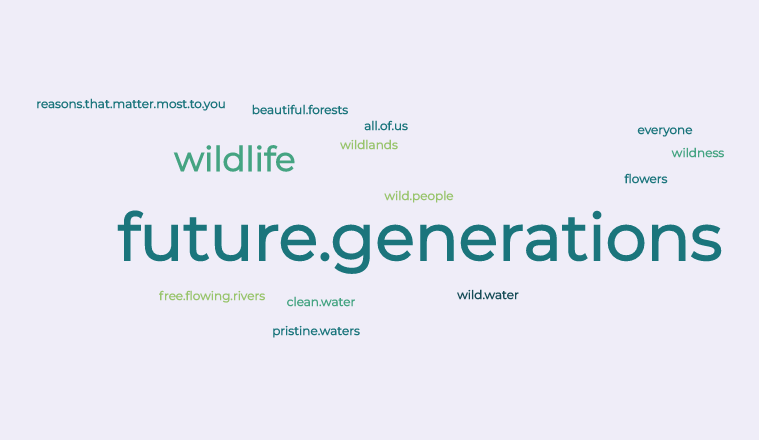


CONNECT WITH US


| The bi-annual newsletter of Friends of Plumas Wilderness |
What is protection? What do we protect in an era of climate chaos and ecosystem collapse?
The most “protected” area on the Plumas National Forest is threatened by cattle grazing.
This summer, Plumas National Forest leaders authorized grazing in the Mount Pleasant Research Natural Area, located in the center of the Bucks Lake Wilderness. This decision was made despite the previous District Ranger indicating the area had not been grazed for several years and a thorough review of environmental effects would be completed prior to renewing the permit.
FOPW supports grazing on public lands but grazing in the Mt. Pleasant Research Natural Area comes at a significant cost to society and only benefits a few. It is not only inconsistent with the purpose of Research Natural Areas, it goes against the definition of conservation, as expressed by the Father of the Forest Service, Gifford Pinchot: “The greatest good of the greatest number in the long run.”
Please take the time to learn more about the many values of the Mt. Pleasant Research Natural Area and email Plumas National Forest leaders to let them know how you feel about grazing in the protected area. As Woodsy Owl says: “Give a Hoot!”
Learn. Explore. Protect.
Merriam-Webster defines protection as 1: to cover or shield from exposure, injury, or destruction; 2: to maintain the status or integrity of… Part of FOPW’s mission is to “maintain the integrity of natural ecosystems”.
Early this year FOPW launched the Protect Plumas Initiative to seek input on what people love about our local public lands, learn what concerns they have, and determine how to best conserve the Upper Feather River Watershed.
Shortly after FOPW launched Protect Plumas, the Plumas National Forest announced the Community Protection Project, aimed at reducing fuels in the Wildland Urban Interface (WUI). FOPW strongly supports this effort and will work with the Forest Service to ensure sensitive natural and cultural resources in project areas are protected.
In addition to protecting our communities, there needs to be a plan to protect our public working lands and wildlands. The Community Protection Project will fall short unless there is a watershed-wide plan to thin fuels and restore fire in strategic locations across the Sierra and Cascades.
“What is the use of a house if you haven’t got a tolerable planet to put it on?”
Henry David Thoreau
Please take the time to read The Equinox and learn about our LOCAL|WiLD, upcoming FOPW events, and what you can do to protect this place we love. I hope the newsletter inspires you to join Friends of Plumas Wilderness and become part of the movement to Protect Plumas.
Enjoy fall and winter!
Darrel

Dear Friends,
What is changing in your life? Fall is here, and the seasonal change invites reflection about our own transitions. Whether it’s people in our lives coming or going, changes in our physical spaces or physical selves, career changes, opportunities or accidents: we can think about transitions as something that upsets our apple cart or that provides us with a fresh start.
Nature is also in transition, especially as our forests start the process of recovery post-wildfire. Ecological succession is so evident after such large-scale disturbance – everywhere I go in the footprint of the Dixie or North Complex fires, I see conifer seedlings popping up, aspen sprouts with huge leaves, chaparral species greening up hillsides.
WiLD RIVERS, RUGGED CANYONS, DIVERSE FORESTS
As Autumn arrives, I feel a mixture of relief, excitement, and diffidence. The rains have come without locally generated smoke and flames filling our skies (relief). I am wildly motivated about what Friends of Plumas Wilderness is working on and loaded with positive energy for our future plans (excitement)! Yet I feel some hesitance … my heart wants to act but I feel inner restraint due to what I see happening (diffidence) … will behaviors of so many around me ever change, wasting the limited amounts of everything as if limits don’t exist?
I do know I am a work in progress. I strive to stay open, maintain balance, give and receive support, seek solace in the natural world. Change is part of life and being there for each other through good times and tough times helps us feel those transitions deep. The root of succession is success, and to me, success is accepting change.
Keep it WiLD!
Darla
p.s.: Speaking of transitions, we are searching for my successor – the next Executive Director of FoPW. If you or anyone you know might be interested, check out the position description here. Thanks!
This year, Friends of Plumas Wilderness launched the Protect Plumas initiative to create a locally-led, shared conservation vision for the Upper Feather River Watershed. Protect Plumas will be carried out in four phases through 2022 and into 2023.
Our staff gave over 20 Protect Plumas presentations to a variety of audiences, including: Plumas County Supervisors, local Tribes, land trusts, conservation & recreation organizations, and local clubs. Attendees provided valuable input that we incorporated into our 2030 Conservation Strategy for Public Lands in the Upper Feather River Watershed – and we always welcome more input. |
| FoPW conducted a survey seeking input on public values and attitudes toward the wildlands and waters of the Upper Feather River Watershed. Three-hundred and eighty people took the survey between March 1st and July 6th, 2022. Demographics reflect a cross-section of age and gender, and people with strong connections to the Upper Feather River Watershed. |

The values section of the survey revealed that clean water, clear air, and fish & wildlife habitat were valued by respondents much more highly than natural quiet or recreation activities. Similarly, respondents were concerned about supplying clean water, improving forest management, and improving fish & wildlife habitat, while providing recreation opportunities and enhancing local economies were not as important. Thus, the survey indicated that ecosystem health and services are priorities over amenities and economics.
Eighty percent of respondents support more protections in the Upper Feather River Watershed (see graph below) with strongest support for Wild & Scenic Rivers (87%) and Wilderness (83%).

Friends of Plumas Wilderness acknowledges that our public lands were taken from Indigenous people against their will and strives to include Native voices in all aspects of our work. FoPW Tribal Liaison, Lethi Watson has been working with local Tribes to create a shared conservation vision. We are very proud that the Konkow Valley Band of Maidu and Enterprise Rancheria have signed letters of support for the Protect Plumas Initiative! |

The Upper Feather River Watershed (UFRW) lacks protections when compared to the United States (12%) and California (24%). Only 7% of lands in the Upper Feather River Watershed are permanently protected and managed for biodiversity. Of these lands, 4% are public and 3% are private.
The central and southern Sierra Nevada have a much greater proportion of permanently protected lands: over 25%. Yet the lower elevation Forest Service lands in the UFRW are exceptionally diverse. Protection of lands and waters where the Sierra and Cascades meet will conserve wildlife corridors and provide nature-based solutions to the climate and biodiversity crises.

| Because the Upper Feather River Watershed lacks protections compared with our region, state, and country, our local public lands may be targeted for future water, power, and mining development. Increasing protections in our region would ensure more of our rivers continue to run free and lands are left in a natural condition. WiLD RIVERS = CLEAN WATER There are four tools for permanently protecting US Forest Service lands: Wilderness, Wild & Scenic Rivers, Research Natural Areas, and National Monuments. Each has different purposes and paths to protection. Presently, there are 3 Wilderness Areas (56,393 acres), 1 Wild & Scenic River (77.6 miles; 19,000 acres), 3 Research Natural Areas (2,099 acres) in the UFRW for a total of 4% protected. Protect Plumas presentations and the public opinion survey helped FoPW determine what people value about our watershed and how these values might best be protected. The following themes rose to the top: |
| Free-flowing rivers and rugged canyons at California’s HeadwatersWaters and lands crucial to Indigenous culturesRelics reflecting diverse perspectives from the pastCritical habitats connecting the Sierra & CascadesDiverse forest ecosystems with a history of scientific study |
| Working with key partners we can achieve our vision to protect and restore a vast network of wildlands and free-flowing rivers spanning the Upper Feather River Watershed. LEAVE IT WiLD! |
| Friends of Plumas Wilderness is hosting a Field Trip Series where participants can learn about tools for protection on Forest Service lands from experts. See How You Can Help to learn more about our upcoming outings. |

| On September 10th, twenty-five people trekked to the summit of Wheeler Peak to see the globally rare Baker cypress. The stand of Baker cypress on Wheeler Peak is the southernmost of only eleven populations on Earth and has the largest individual of the species. The two Baker cypress stands on the Plumas National Forest are within two units of the Mud Lake Research Natural Area. Both burned with the Dixie Fire. |

Forest Service Ecologist Kyle Merriam has conducted research on all eleven populations of Baker cypress and shared that the species was once more widespread but only persists in a few small populations today. Fire suppression was a threat to the fire-dependent species, which holds all of its cones and only releases them when the tree burns at high severity. Now, frequently recurring high severity fires make the species vulnerable, as trees do not have enough years between fires to set seed.
Highlights of the outing were seeing carpets of seedlings that sprouted since the Dixie Fire and standing under the largest specimen of the species, the Champion Tree, which was singed but did not entirely burn.

Plumas National Forest Wildland Fire Management Specialist Ryan Bauer said that “in the coming decades we will lose a jaw-dropping amount of Sierra forests to wildfire.” When journalist Jane Braxton-Little asked, “What can we as individuals do to maintain populations of Baker cypress?” Merriam said if people value biodiversity, they should let Forest Service leaders know it. She added that the scale of the wildfire crisis requires large scale solutions that protect both communities and the biodiverse forests that surround them.
Like Merriam, Bauer emphasized the need for a watershed-wide approach to fuels reduction. He discussed the need to remove fuels from our forests using all appropriate tools, including prescribed fire.

This year, FOPW identified and designated the Valley Creek Special Interest Area as the first Old Growth Forest Network site in Plumas County. On August 8, 2022, FOPW and partners hosted the celebration attended by people of all ages from throughout the region.
Sarah Hoffman, Friends of Plumas Wilderness summer intern, planned the event, which drew more than 30 people. “For my Quincy High School senior project I worked with Michelle Coppoletta on an inventory of Valley Creek, and now I get to bring it full circle and see the area designated as a Network Forest,” Hoffman said.
With over 100 years of fire suppression the composition and structure of the Valley Creek stand has changed. Shade-tolerant white fir has significantly increased in number and grown into the canopies of much larger ponderosa pine, Douglas-fir, and incense cedar. Because of the continuous canopy, fire has a higher potential of being stand replacing.
To reduce the likelihood of losing the old growth stand to fire, the Forest Service has hand-thinned small-diameter trees using chainsaws and piled the slash to burn when conditions allow. This treatment will also make the forest more resilient to drought, insects, and disease. Future plans within the SIA are to thin remaining areas with high tree densities and underburn the area. Public lands surrounding the SIA will be thinned using mechanized equipment and provide a buffer for future prescribed fires.
The Forest Service and FOPW plan to install interpretive signs in the Valley Creek SIA that will inform the public of the importance of mature and old growth trees and the need to thin forests after more than 100 years of fire suppression.

The 1,315-acre Mt. Pleasant RNA was established in 1990 to protect unique red fir forests and fens. Fens are a type of wetland ecosystem supported by groundwater and have soils with very high levels of organic matter, which are easily eroded if the hydrology of the fen is altered.
Fens are important reference ecosystems and may contain thousands of years of layered peat that scientists can take cores of to develop chronologies of past vegetation, fire frequency, and climate by analyzing pollen and ash. Because fens sequester significant amounts of carbon, they provide unique climate research sites. They are also key ecosystems to protect for nature-based solutions to the climate crisis.
Plumas National Forest leaders authorized the use of grazing in the Mt. Pleasant RNA this year despite the Dixie Fire having caused significant damage to the area, destroying fences established to protect degraded fen wetlands. Allowing grazing immediately after the fire without restoring fencing or allowing vegetation to recover puts sensitive resources at great risk of negative effects from livestock grazing.
| Email local Forest Service leaders about the authorization of grazing in the Mt. Pleasant RNA |
| Christopher Carlton, Forest Supervisor christopher.carlton@usda.gov Plumas National Forest 159 Lawrence Street Quincy, CA 95971 Joe Hoffman, District Ranger joseph.hoffman@usda.gov Mt. Hough Ranger District 39696 Highway 70 Quincy, CA 95971 |
This May Day our board and staff hosted over 50 past FOPW leaders and long-time supporters in Meadow Valley. Executive Director, Darla DeRuiter said that the date was chosen because May Day is a traditional day to celebrate spring and “mayday” is an international distress signal.
On the bluebird day we celebrated the promise of spring and put out the call that FOPW needs help if we hope to save old growth forests, wild rivers, and wild land for future generations. After FOPW shared information about the Protect Plumas Initiative, past leaders and supporters told tales about colorful characters Wayne Dakin and Wilbur Vaughan, who both were influential leaders of Friends of Plumas Wilderness in the early days and had the foresight to protect the old growth forests and wild places that we enjoy today.
Thanks to all of you who joined us!

After nearly 50 years, FOPW hired our first Executive Director when Darla DeRuiter stepped up last year. This year we hired Lethi Watson as Tribal Liaison, Shane Koskinen as Outreach & Education Director, Helen Lewis as Monitoring & Stewardship Director, Mya Wilson as a Field Technician, and Sarah Hoffman as an Intern.
After an amazing summer full of accomplishments all but Darla and Lethi are returning to college: Shane to his position with the Outdoor Recreation Leadership program at Feather River College, Helen to finish her degree at Humboldt, Mya to FRC, and Sarah to Cal Poly San Luis Obispo.
FoPW is in the process of interviewing people for Conservation & Planning and Organization & Finance positions. We continue to seek an Executive Director, as Darla is planning her second retirement. If you know anyone who has a passion for wild things and is qualified please direct them to our website or let Darla know.

The FOPW Annual Retreat was held at Brady’s Camp on July 22-23. During the campout we drafted an 18-month Strategic Plan that outlines goals, objectives, and action items for FOPW’s four areas of work: Organization & Finances, Outreach & Education, Advocacy & Planning, and Monitoring & Stewardship. All goals tier to our Mission: to study, explore, and maintain the integrity of natural ecosystems where the Sierra and Cascades meet.


Become a MONTHLY donor or select Annual membership to make your life easy and keep supporting
Friends of Plumas Wilderness on a regular basis.
Your support means so much.
Leave it WiLD!
The FOPW office has moved to 546 Lawrence Street in Quincy, across the street from Morning Thunder. Drop by, become a member, and get some stickers or a shirt. We are looking for a few new / used things for the office.
Make our work more effective and efficient in the office by donating any of the following.
Please, only clean items in good condition. And thank you!
Amazon donates 0.5% of eligible purchases to non-profit organizations of your choosing through a program called Amazon Smile. Friends of Plumas Wilderness is part of this program – just go to smile.amazon.com, sign in with the same account you use for Amazon.com, and select Friends of Plumas Wilderness for your target non-profit! What an easy way to support us as we work to protect more public lands in the Upper Feather River Watershed.
The third outing of our Field Trip Series is this Saturday, September 24th! Join us at Jamison Creek to learn about Wild & Scenic Rivers with Josh Olivera and Darla DeRuiter. It’s a gorgeous spot, especially this time of year!

The rest of the series continues in October, with an adventure to Grizzly Peak Inventoried Roadless Area with Bill Battagin and several FOPW board members. Learn about what IRAs are, and what it takes to get permanent protection there. That event is October 22nd at 10am.

| At the West End Theater on Wednesday, November 16 at 7pm, we are honored to host Charles Wilkinson for a talk entitled “Is a National Monument the right fit for Plumas?”. |

Charles Wilkinson is the Moses Lasky Professor of Law Emeritus at the University of Colorado, where he has also been named as Distinguished Professor, the highest honor that university bestows on its faculty. After graduating from Stanford Law School and practicing with Phoenix and San Francisco firms, Wilkinson joined the Native American Rights Fund in 1971 as a staff attorney. Since 1975, he has taught at the Oregon and Colorado law schools, receiving many teaching and research awards and teaching courses like Native American Law and Natural Resources Law.
His fourteen books include the standard law casebooks on Indian Law and Federal Public Land Law. He has also authored general audience books such as Crossing the Next Meridian: Land, Water, and the Future of the West (1992); Fire on the Plateau: Conquest and Endurance in the American Southwest (1999); and Blood Struggle: The Rise of Modern Indian Nations (2005).
Over the years, Wilkinson has been involved in many tribal partnerships related to land protection. He drafted the Presidential Proclamation, signed by President Clinton in 1996, establishing the Grand Staircase-Escalante National Monument in Utah. He facilitated negotiations between the National Park Service and the Timbisha Shoshone Tribe regarding tribal lands in Death Valley National Park resulting in Congressional action in 2000. He served as Special Advisor to the Bears Ears Inter-Tribal Coalition in regard to the creation of the Bears Ears National Monument, proclaimed by President Obama in 2016.
Wilkinson has long been connected to the Upper Feather River Watershed and visits often. His mother-in-law moved to Quincy in the 1960s and ran the fabric store on Jackson for many years. His wife Ann’s sister, Jean McMorrow, grew up in Quincy and Ann’s niece Jamie Winter owns Mountain Building Supply with her husband Sasha.

All ten 60-90 second videos we filmed in May are now posted on our website, YouTube channel, and Instagram feed! At the end, we asked each person to fill in the blank: ‘Protect Plumas for…’ Here is a compilation of what everyone said – what would you add?
